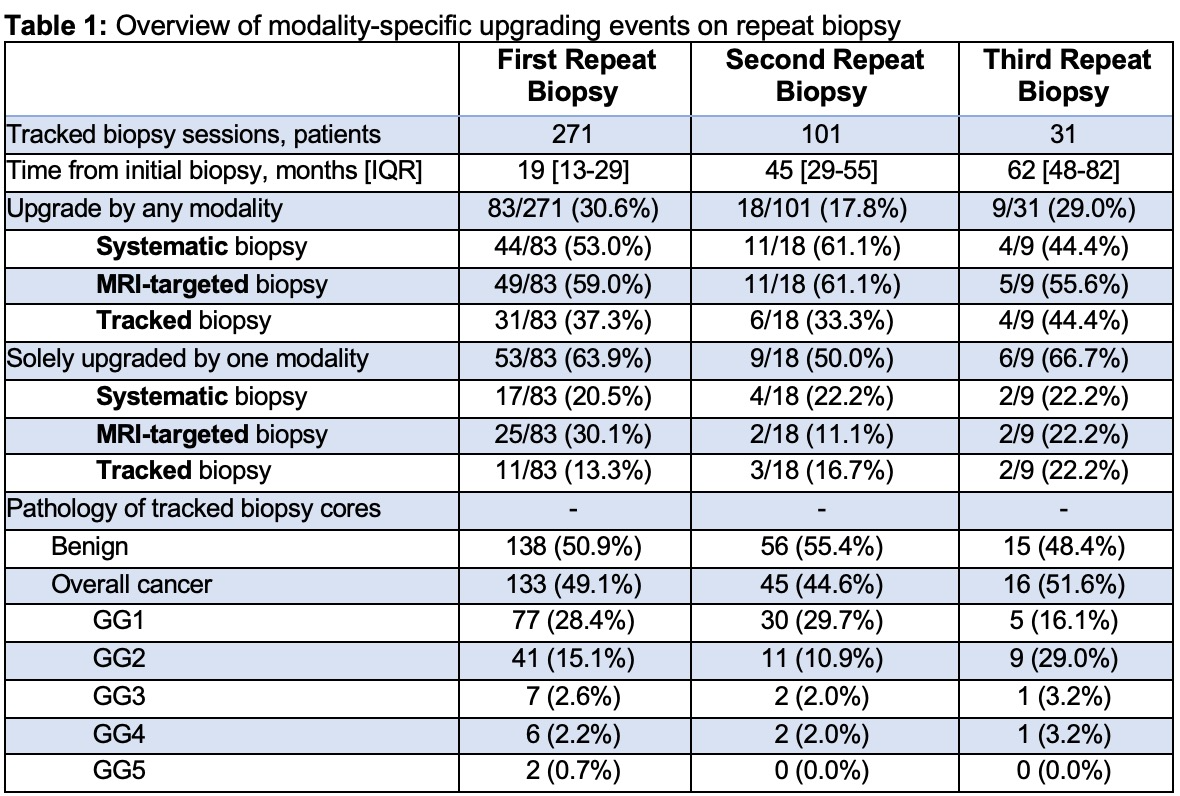Back
Introduction: Monitoring MRI-invisible prostate cancer remains a challenge for patients on active surveillance (AS) due to an inability to reliably re-biopsy tumors without an associated lesion on MRI. In this study, we sought to describe our experience using a prostate image-fusion platform in tracking MRI-invisible lesions in patients on AS, as well as to determine differences in cancer detection and upgrading rates between systematic, MRI-targeted, and tracked biopsies.
Methods: A prospectively maintained AS database was queried for patients with =1 tracked prostate biopsy session. Needle trajectories of all biopsy cores were saved using the UroNav™ (Philips) platform. Patients underwent MRI/US guided biopsies of systematic and MRI-targeted lesions via transperineal or transrectal approaches. Tracked biopsy was defined as a repeat MRI/US fusion-guided biopsy which re-targeted regions corresponding to previously positive systematic cores not associated with MRI visible lesions. Gleason grade was compared between initial and subsequent biopsy sessions for all three biopsy modalities: systematic, MRI-targeted, and tracked.
Results: Between 2009-2022, 271 patients on AS with =1 tracked biopsy sessions were identified. 101/271 (37.3%) had two tracked biopsy sessions and 31/271 (11.4%) had three. The median time from initial to subsequent biopsy session was 19 months (IQR: 13-29). Among 271 patients, there were 83 upgrading events captured by the three modalities on first repeat biopsy (Table 1). On first repeat biopsy, 31/83 (37.3%) upgrading events were identified by tracking, with 11/83 (13.3%) identified only on tracking biopsy. Of the 110 total upgrading events between the three repeat tracked biopsy sessions, 41/110 (37.3%) were captured on tracking, with 16/110 (14.5%) discovered solely by tracking. The median number of biopsy cores for systematic, MRI-targeted, and tracked approaches were 12, 4 (IQR: 2-4), and 2 (IQR: 2-4), respectively.
Conclusions: In this series, a significant portion of upgrading events for patients on AS were uniquely identified on tracked biopsy and would have otherwise been missed on repeat systematic and MRI-targeted biopsy. Notably, given the low number of additional biopsy cores required for tracking, this approach may be an appropriate and low-risk supplement to standard AS protocols. SOURCE OF
Funding: N/A

Moderated Poster Session
Session: MP38: Prostate Cancer: Localized: Active Surveillance
MP38-09: Tracking MRI-Invisible Lesions During Active Surveillance
Saturday, April 29, 2023
1:00 PM – 3:00 PM CST
Location: S403
- DN
Poster Presenter(s)
Introduction: Monitoring MRI-invisible prostate cancer remains a challenge for patients on active surveillance (AS) due to an inability to reliably re-biopsy tumors without an associated lesion on MRI. In this study, we sought to describe our experience using a prostate image-fusion platform in tracking MRI-invisible lesions in patients on AS, as well as to determine differences in cancer detection and upgrading rates between systematic, MRI-targeted, and tracked biopsies.
Methods: A prospectively maintained AS database was queried for patients with =1 tracked prostate biopsy session. Needle trajectories of all biopsy cores were saved using the UroNav™ (Philips) platform. Patients underwent MRI/US guided biopsies of systematic and MRI-targeted lesions via transperineal or transrectal approaches. Tracked biopsy was defined as a repeat MRI/US fusion-guided biopsy which re-targeted regions corresponding to previously positive systematic cores not associated with MRI visible lesions. Gleason grade was compared between initial and subsequent biopsy sessions for all three biopsy modalities: systematic, MRI-targeted, and tracked.
Results: Between 2009-2022, 271 patients on AS with =1 tracked biopsy sessions were identified. 101/271 (37.3%) had two tracked biopsy sessions and 31/271 (11.4%) had three. The median time from initial to subsequent biopsy session was 19 months (IQR: 13-29). Among 271 patients, there were 83 upgrading events captured by the three modalities on first repeat biopsy (Table 1). On first repeat biopsy, 31/83 (37.3%) upgrading events were identified by tracking, with 11/83 (13.3%) identified only on tracking biopsy. Of the 110 total upgrading events between the three repeat tracked biopsy sessions, 41/110 (37.3%) were captured on tracking, with 16/110 (14.5%) discovered solely by tracking. The median number of biopsy cores for systematic, MRI-targeted, and tracked approaches were 12, 4 (IQR: 2-4), and 2 (IQR: 2-4), respectively.
Conclusions: In this series, a significant portion of upgrading events for patients on AS were uniquely identified on tracked biopsy and would have otherwise been missed on repeat systematic and MRI-targeted biopsy. Notably, given the low number of additional biopsy cores required for tracking, this approach may be an appropriate and low-risk supplement to standard AS protocols. SOURCE OF
Funding: N/A

